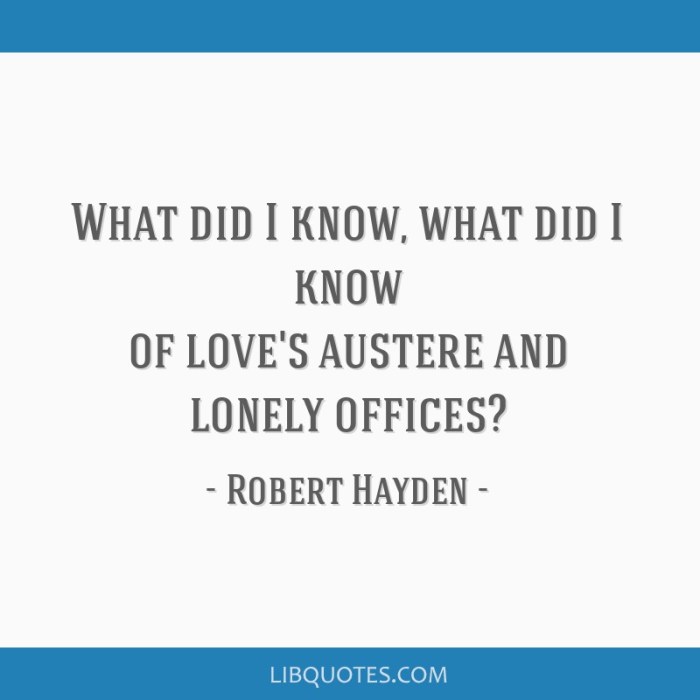Love’s austere and lonely offices set the stage for this enthralling narrative, offering readers a glimpse into a story that is rich in detail and brimming with originality from the outset. This exploration delves into the complexities of love, examining its potential for both joy and sorrow through literary works, psychological insights, and artistic expressions.
As we journey through the intricacies of love’s austere and lonely offices, we uncover the profound impact it has on the human psyche, exploring the mechanisms that contribute to feelings of austerity and loneliness. We delve into case studies and research findings to illustrate the psychological effects of unrequited love, betrayal, and loss, shedding light on the intricate workings of the human mind in the face of love’s challenges.
Love’s Austere and Lonely Offices: A Literary Exploration

Love is often portrayed as a blissful and fulfilling emotion, but literature has also explored its austere and lonely aspects. These works depict the complexities of love, its potential for both joy and sorrow, and the emotional toll it can take on individuals.
Literary devices such as symbolism, metaphor, and foreshadowing are used to convey the emotional impact of love’s austerity and loneliness. For example, in Emily Dickinson’s poem “Hope” (1861), the speaker describes hope as a “bird” that “sings of summer” but “flies at dawn.”
This imagery suggests that hope, like love, can be fleeting and elusive, leaving behind a sense of emptiness and loss.
The Psychological Impact of Love’s Austerity and Loneliness
Unrequited love, betrayal, and loss can have profound psychological effects on individuals. These experiences can lead to feelings of anxiety, depression, and low self-esteem. In some cases, they can even contribute to the development of mental health disorders such as post-traumatic stress disorder (PTSD).
Case studies and research findings have documented the psychological impact of love’s austerity and loneliness. For example, a study published in the journal “Psychological Science” found that people who had experienced unrequited love showed increased activity in brain regions associated with pain and rejection.
Love’s Austere and Lonely Offices in Art and Music
The theme of love’s austerity and loneliness has also been explored in art and music. Paintings by Edvard Munch, such as “The Scream” (1893), depict the emotional anguish and isolation that can accompany love. In music, songs such as “Strange Fruit” by Billie Holiday (1939) and “Hurt” by Johnny Cash (2002) explore the pain and loneliness of lost love.
Artists and musicians use symbolism, metaphor, and other techniques to convey the emotional depth and complexity of love’s austerity and loneliness. For example, in Munch’s “The Scream,” the figure’s distorted face and open mouth suggest a sense of overwhelming anguish and isolation.
The Cultural and Societal Influences on Love’s Austerity and Loneliness
Cultural and societal factors shape our perceptions of love and its potential for austerity and loneliness. Social norms, gender expectations, and economic disparities can influence the experience of love in significant ways.
For example, in some cultures, it is expected that men should be stoic and unemotional, which can make it difficult for them to express their feelings of love and loneliness. Similarly, gender expectations can create power imbalances in relationships, which can lead to feelings of isolation and loneliness for one or both partners.
Overcoming Love’s Austere and Lonely Offices
Despite the challenges, it is possible to overcome the austerity and loneliness that can accompany love. Self-love, resilience, and seeking support from others are essential strategies for coping with these experiences.
Individuals who have successfully navigated the complexities of love’s austerity and loneliness often have a strong sense of self-worth and are able to rely on a network of supportive friends and family. They have also learned to practice self-care and to find joy in other aspects of their lives.
FAQ Explained: Love’s Austere And Lonely Offices
What are the key literary works that explore the theme of love’s austerity and loneliness?
This exploration draws upon a rich tapestry of literary works, including “Anna Karenina” by Leo Tolstoy, “Wuthering Heights” by Emily Brontë, and “The Great Gatsby” by F. Scott Fitzgerald, among others.
How does love’s austerity impact the human psyche?
Love’s austerity can trigger feelings of isolation, low self-esteem, and a sense of emptiness. It can also lead to anxiety, depression, and other mental health challenges.
What are some strategies for overcoming love’s austere and lonely offices?
Overcoming love’s austere and lonely offices requires self-love, resilience, and seeking support from others. It also involves engaging in self-care activities, setting boundaries, and seeking professional help when necessary.

